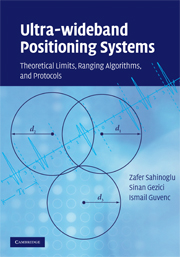Book contents
- Frontmatter
- Contents
- Preface
- 1 Introduction
- 2 Ultra-wideband signals
- 3 Ultra-wideband channel models
- 4 Position estimation techniques
- 5 Time-based ranging via UWB radios
- 6 Ranging protocols
- 7 Special topics in ranging
- 8 Practical considerations for UWB system design
- 9 Recent developments and future research directions
- References
- Index
3 - Ultra-wideband channel models
Published online by Cambridge University Press: 23 December 2009
- Frontmatter
- Contents
- Preface
- 1 Introduction
- 2 Ultra-wideband signals
- 3 Ultra-wideband channel models
- 4 Position estimation techniques
- 5 Time-based ranging via UWB radios
- 6 Ranging protocols
- 7 Special topics in ranging
- 8 Practical considerations for UWB system design
- 9 Recent developments and future research directions
- References
- Index
Summary
Wireless channel models carry significant importance for gaining insight into designing physical layer systems and selecting certain system parameters. For instance, in an IRUWB system, a design engineer might need to know how much apart to transmit two sequential pulses in order to avoid inter-frame interference at the receiver, or how likely the first arriving signal component contains the highest energy among all signal components for accurate ranging. Answers to such questions can be obtained either directly from channel measurements conducted in an environment of interest, or from statistical models derived from channel measurement campaigns.
There are various channel modeling techniques (e.g. ray tracing and statistical modeling) [93–96] and channel sounding methods (e.g. time-domain vs. frequency domain) [97, 98], which have been studied extensively in the literature. The focus of this chapter is not those well-known channel modeling techniques, but mainly the UWB channel models recently proposed and their interpretations for positioning applications.
Many UWB channel modeling campaigns have been performed within the past few years, mainly due to emerging UWB standards (e.g. multiband OFDM-UWB, IEEE 802.15.4a, and IEEE 802.15.3c) [96, 97, 99–101]. Although channel statistics and models of various frequency bands are publicly available, many of those do not explicitly include ranging-related statistics. Therefore, one of the aims of this chapter is to investigate UWB channel models from a range estimation perspective.
Designing a wireless system typically involves the steps illustrated in Fig. 3.1. First, application requirements need to be explored. Low attenuation at low frequencies makes through-the-wall communications and tracking applications attractive, but it is difficult to adopt sub-GHz UWB systems due to coexistence issues with existing narrowband systems.
- Type
- Chapter
- Information
- Ultra-wideband Positioning SystemsTheoretical Limits, Ranging Algorithms, and Protocols, pp. 44 - 62Publisher: Cambridge University PressPrint publication year: 2008



